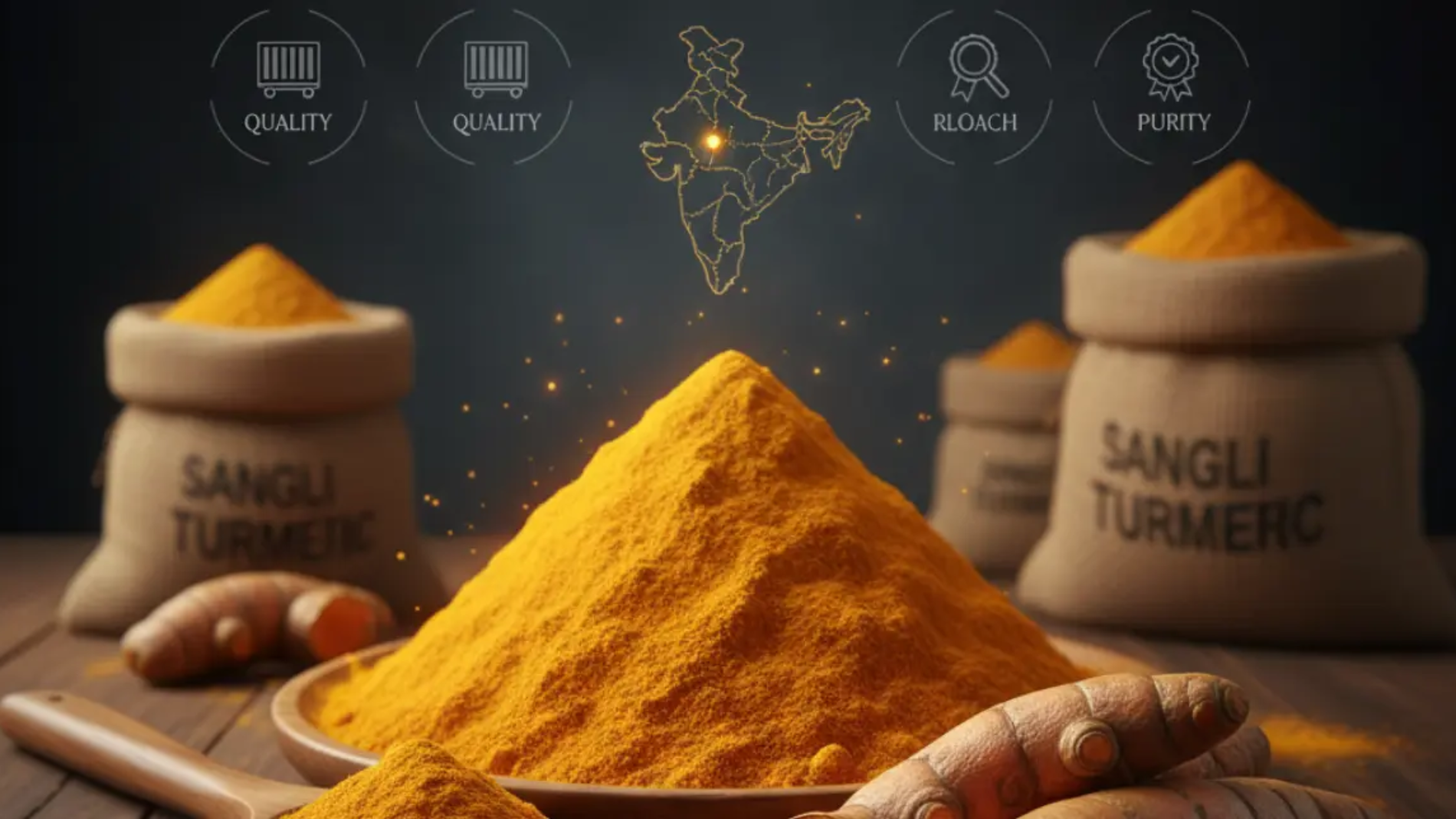For the world’s largest spice brands and food manufacturers, sourcing is a high-stakes game of strategy. When a brand’s reputation is built on the consistent flavour of its signature curry powder or the vibrant colour of its seasoning blend, the choice of an ingredient supplier is never left to chance. This is why, when it comes to turmeric, the name “Sangli” is on the specification sheet of some of the most respected brands in the industry.
While India is dotted with turmeric growing regions, the market in Sangli, Maharashtra, holds a unique and powerful position. It is not just a place; it’s an ecosystem of quality, scale, and trust. From our position here in Pune, at the heart of Maharashtra, we have a clear view of why Sangli Turmeric has become a strategic asset for global players.
1. The Power of Scale and Supply Chain Security
The number one priority for a large-scale manufacturer is a reliable, uninterrupted supply chain. The Sangli turmeric market is one of the most significant trading hubs in India, and indeed, the world. This isn’t a small, local market; it’s a massive nexus where vast quantities of turmeric from across the fertile Deccan Plateau are aggregated.
This scale provides a crucial advantage: consistency through volume. By sourcing from a hub like Sangli, experienced suppliers can select and blend numerous high-quality lots to create large, homogenous batches. This process smooths out the minor variations that can occur from farm to farm, resulting in a final product with a highly predictable flavour, colour, and curcumin profile. This ensures that the bulk turmeric a brand buys in October is identical to the batch they procure the following March.
2. The GI Tag: An Ironclad Guarantee of Authenticity
In an era of increasing demand for traceability, the Geographical Indication (GI tag) for “Sangli Halad” (Sangli Turmeric) is a game-changer. This legal protection, recognized internationally, certifies that the turmeric has been grown in the specific geographic region of Sangli and possesses the unique qualities attributed to that origin.
For a global brand, this is an invaluable asset. The GI tag provides:
Brand Protection: It eliminates the risk of sourcing inferior turmeric from other regions that may be falsely marketed as Sangli.
Traceability and Trust: It offers a verifiable link back to the source, a powerful story for today’s conscious consumer.
A Mark of Premium Quality: The GI tag immediately elevates the ingredient to a premium status, assuring the buyer of its authenticity.
Spice Up Your Business with Authentic Indian Flavors
Import and Export Excellence from India!

3. The "Raja Puri" Advantage: A Consistent and Desirable Quality Profile
Sangli is particularly famous for cultivating the superior “Raja Puri” turmeric variety. This specific cultivar is renowned for its desirable characteristics that are perfectly suited for food manufacturing.
The Raja Puri turmeric is prized for its long, well-formed fingers, its deep orange-yellow colour, and a balanced curcumin content. Unlike some varieties that are bred for extremely high curcumin, Sangli’s offering provides a moderate, consistent potency that is ideal for a wide range of spice blends. Its warm, earthy flavour provides a solid foundation without overpowering other ingredients, making it the perfect, versatile workhorse for complex formulations.
4. A Mature Ecosystem of Expertise and Infrastructure
A major trading hub like Sangli is more than just a marketplace; it’s a mature ecosystem of expertise. The region is home to:
Experienced Farmers: Generations of farmers with deep knowledge of cultivating high-quality turmeric.
Modern Processing Units: Facilities with the technology for cleaning, drying, polishing, and grinding turmeric to meet stringent international standards.
Knowledgeable Exporters: Professional spice exporters who understand the nuances of quality control, packaging, and the complex documentation required for international trade.
This established infrastructure ensures that a buyer is not just purchasing a raw commodity, but a professionally handled and processed ingredient, complete with a comprehensive Certificate of Analysis (COA) to verify its quality and safety.
In conclusion, the decision by the world’s leading brands to source Sangli Turmeric is a strategic one, based on the undeniable advantages of scale, authenticity, consistent quality, and a reliable professional ecosystem.
Frequently Asked Questions (FAQs)
1. What does the GI tag for Sangli Turmeric guarantee?
The Geographical Indication (GI) tag guarantees that the turmeric originates from the Sangli district and surrounding areas in Maharashtra, India, and possesses the specific qualities and reputation associated with that region.
2. What is the “Raja Puri” variety of turmeric?
“Raja Puri” is the premier cultivar of turmeric grown in the Sangli region. It is famous for its large, well-formed fingers, deep colour, and a balanced, commercially desirable curcumin content.
3. What is the typical curcumin content of Sangli Turmeric?
Sangli Turmeric is prized for its consistency, with a curcumin content typically ranging from 3% to 4.5%. This makes it a perfect all-rounder for food applications.
4. How does Sangli turmeric compare to other GI-tagged varieties like Erode?
Both are excellent GI-tagged varieties. Sangli, from Maharashtra, is particularly famous for its “Raja Puri” finger and its massive trading volume. Erode, from Tamil Nadu, is another high-quality all-rounder. The choice often depends on a buyer’s specific preference for flavour nuances and finger size.
5. Is Sangli Turmeric better for food manufacturing or for nutraceuticals?
With its balanced profile, it is an exceptional choice for food manufacturing and creating spice blends. While it can be used in nutraceuticals, varieties with exceptionally high curcumin (like Alleppey or Lakadong) are often specifically sought for extraction purposes.
6. What is a Certificate of Analysis (COA) and why is it important?
A COA is a lab report that provides a scientific analysis of a specific batch of turmeric. It verifies key quality parameters like curcumin content, moisture level, purity, and microbiological safety. It is an essential document for any professional buyer.
7. When is the main harvest and trading season for Sangli Turmeric?
The main turmeric harvest in the Sangli region is from January to March. The peak trading season in the market follows shortly after, from February through May.
8. How do I find a reliable supplier for authentic Sangli Turmeric? Look for an experienced Indian turmeric supplier who is a registered exporter with the Spices Board of India. They should be transparent about their GI authorization and be able to provide comprehensive documentation and samples for your evaluation.
About us
We bridge the gap between local producers and global markets, ensuring seamless trade facilitation with exceptional quality and reliability. We provide quick delivery services with customized packaging with all approval of International Certificates (Spices board India, MSME, IEC, fssai, FIEO, APEDA, EU certification, FDA and Many More)
Contact us
Shop No. 3, Ganesh Prestige Sr. No. 2/15, Near Laxmi Jewellers, Dhanakawadi, Pune – 411043, Maharashtra INDIA.
Call On
+91 9545205050
+91 9822422584



Leave A Comment